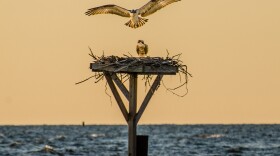Next week the U.N. will bring experts from around the world for a climate change summit in New York. On the Chesapeake Bay scientists are looking at what a warmer bay might mean for species like the blue crab and striped bass.
Professor Rom Lipcius, at the Virginia Institute of Marine Science has been crunching numbers from annual winter blue crab surveys since 1990. He says the bay has warmed by half a degree more per decade than the global average. Because the bay sits right in the middle of two different climates: temperate to the north and sub-tropical to the south, the impact on marine life will be significant.
"As the bay warms then we're gonna lose temperate species. So that biogeographical boundary will shift a little further north and so the Chesapeake will be more within the sub-tropical region than the temperate region," says Lipcius.
Vincent Saba, a scientist with the National Oceanic and Atmospheric Administration, says scientists are trying to figure out why places like the bay are warming faster than in global oceans."That warming that we've observed is definitely significant for a lot of the commercial species that are in the Chesapeake and on the northeast shelf by far."
Lipcius says blue crabs will lose some of their favorite underwater grasses where they shelter and the clams they like to eat."Certain species are going to suffer. Eel grass; the soft-shell clam is a temperate species; the baltic clam is near the southern limit of their range, so those are likely over time going to be eradicated."
Tom Miller directs the University of Maryland's Chesapeake Biological Lab on the Pautuxent River. Water temperature there has increased by 3ºF since the lab first began measuring in 1939. He says the blue crab may be one of the better adapters to climate change."If the climate projections are right and you do that mental shift of moving the Chesapeake Bay to a condition that it would experience were it currently on the border between Georgia and Florida, crabs wouldn't go into this overwintering period and you could fish them year round."
Rom Lipcius says that adaptation is already mapped into the blue crab's genes."The blue crab should do very well because it is of tropical marine evolutionary origins and so it has expanded northward and it's probably going to continue to do so."
But like Miller, Lipcius, says more data is needed."It's a big unknown for the blue crab in terms of ultimately how it's going to fare."
The same is true for fish like the striped bass and summer flounder. Scientists know these species don't adapt easily to climate change because they live longer, have fewer babies, and are already stressed by overfishing, disease and pollution. Both fish are showing up more frequently in Long Island Sound. Fisheries managers call it the new Chesapeake Bay.
"We know many species can adapt remarkably well. Species that currently don't occur in the Chesapeake Bay in any great abundance will likely begin to occur. Like Spanish mackerel and King mackerel that would likely find the Chesapeake Bay a great place to be 60 to 80 years from now," says Tom Miller.
None of this considers other factors like pollution, ocean acidification and overfishing. Saba says scientists have a long way to go."Whether these are significant trends, you need more data to actually determine if they're statistically significant or just a fluke, like one year you happen to get a lot of stripers in Long Island and then you don't get them in the next couple of years, so that's something you need to be mindful of."
NOAA and the National Fisheries Service plan to use data they have to give a snapshot of 79 Northeast species of fish and shellfish most vulnerable to climate change.






